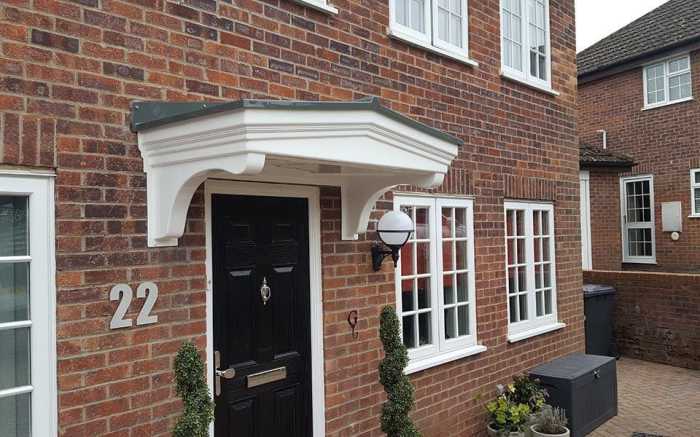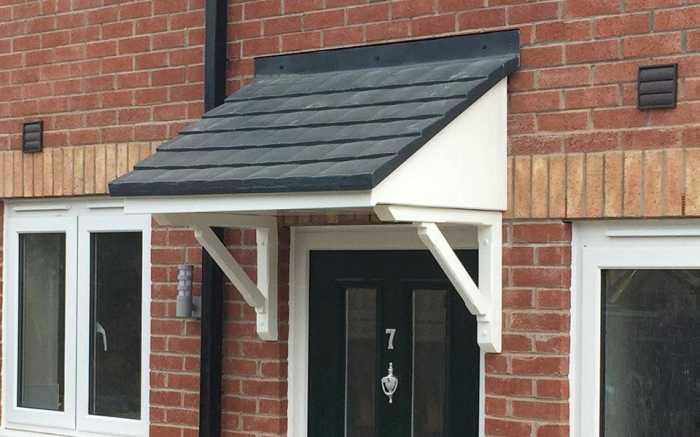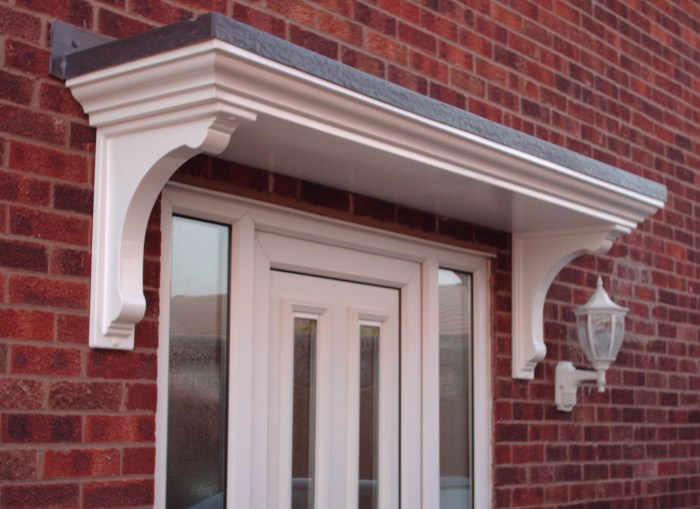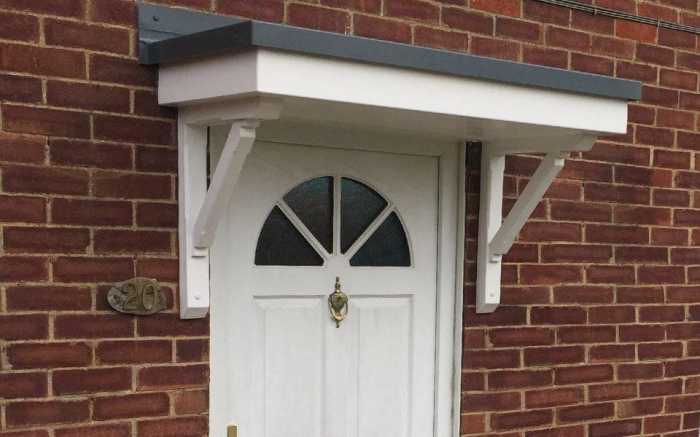Welcome to the realm of front door canopy ideas UK, where we unveil a world of architectural artistry designed to elevate the entrance of your abode. Get ready to explore a symphony of styles, materials, and designs that will transform your doorstep into a captivating focal point.
From the timeless elegance of Victorian canopies to the sleek lines of contemporary designs, this guide will empower you with the knowledge to choose the perfect canopy that complements your home’s architectural style and enhances its overall aesthetic.
Front Door Canopy Design Styles

Front door canopies are a great way to add style and protection to your home. They come in a variety of designs, from traditional to contemporary, so you’re sure to find one that suits your taste. Here are a few of the most popular design styles for front door canopies in the UK:
Victoriancanopies are typically made of wrought iron or cast iron and feature ornate detailing. They are often supported by columns or brackets and have a curved or arched shape.
Georgiancanopies are more understated than Victorian canopies and are typically made of wood or stone. They have a rectangular or square shape and are supported by simple brackets or columns.
Contemporarycanopies are often made of metal or glass and have a sleek, modern design. They are often supported by cables or rods and have a flat or angled shape.
Materials
The materials used to make front door canopies vary depending on the design style. Victorian canopies are typically made of wrought iron or cast iron, while Georgian canopies are typically made of wood or stone. Contemporary canopies are often made of metal or glass.
Materials for Front Door Canopies
Front door canopies are available in a variety of materials, each with its own unique advantages and disadvantages. The most common materials used for canopies are wood, metal, glass, and polycarbonate.Wood canopies are a classic choice that can add a touch of warmth and elegance to your home.
They are relatively easy to install and maintain, but they can be susceptible to rot and decay if not properly sealed.Metal canopies are a durable and low-maintenance option. They are available in a variety of finishes, so you can find one that matches the style of your home.
However, metal canopies can be more expensive than other materials, and they can be noisy in the rain.Glass canopies are a modern and stylish choice that can let in a lot of natural light. They are also relatively easy to clean and maintain.
However, glass canopies can be more expensive than other materials, and they can be damaged by hail or other falling objects.Polycarbonate canopies are a lightweight and shatter-resistant option. They are also UV-resistant, so they will not fade or discolor over time.
However, polycarbonate canopies can be scratched or damaged by sharp objects.
Wood
Wood canopies are a popular choice for their classic look and durability. They are available in a variety of styles, from traditional to contemporary, and can be customized to match the architecture of your home. Wood canopies are relatively easy to install and maintain, but they require regular sealing to protect them from the elements.
Metal
Metal canopies are a durable and low-maintenance option. They are available in a variety of finishes, including copper, aluminum, and steel, and can be customized to match the style of your home. Metal canopies are more expensive than wood canopies, but they are also more durable and require less maintenance.
Glass
Glass canopies are a modern and stylish choice that can let in a lot of natural light. They are available in a variety of shapes and sizes, and can be customized to match the architecture of your home. Glass canopies are relatively easy to clean and maintain, but they are more expensive than wood or metal canopies.
Polycarbonate
Polycarbonate canopies are a lightweight and shatter-resistant option. They are available in a variety of colors and styles, and can be customized to match the architecture of your home. Polycarbonate canopies are relatively easy to install and maintain, but they can be scratched or damaged by sharp objects.
Canopy Shapes and Sizes
Front door canopies come in a wide range of shapes and sizes to suit different architectural styles and personal preferences. The shape and size of the canopy should be carefully considered to complement the size and style of the front door and the overall exterior of the home.
Common canopy shapes include:
- Rectangular:A versatile shape that complements most architectural styles. Available in various sizes to fit any door.
- Arched:Adds a touch of elegance and curves to the front entrance. Ideal for traditional and Victorian-style homes.
- Gable:A classic shape that provides ample coverage and a distinctive look. Suitable for larger front doors.
- Flat:A contemporary and minimalist design that offers a sleek and understated look. Available in various sizes and materials.
Size Considerations
The size of the canopy should be proportionate to the size of the front door. A canopy that is too small will look inadequate, while one that is too large will overwhelm the entrance. As a general rule of thumb, the canopy should extend at least 6 inches beyond the door frame on each side and at least 12 inches beyond the door frame above.
Canopy Roof Options

The roof of your front door canopy plays a significant role in its overall aesthetics and functionality. Here are the different roofing options to consider:
Flat Roofs:These roofs are simple and sleek, offering a modern and minimalist look. They are typically made from materials like metal, plastic, or fiberglass, which are lightweight and easy to maintain. Flat roofs are ideal for contemporary homes and can be integrated seamlessly into the overall design.
Pitched Roofs
Pitched roofs add a touch of traditional charm to your front door. They are sloped at an angle, allowing water to drain easily. Pitched roofs can be made from various materials, including tiles, shingles, or metal. They are more complex to install than flat roofs but offer greater durability and weather resistance.
Curved Roofs, Front door canopy ideas uk
Curved roofs are an elegant and eye-catching option for front door canopies. They can be made from metal or wood and are typically more expensive than flat or pitched roofs. Curved roofs create a unique and inviting entrance to your home, adding a touch of sophistication and style.
Canopy Support Systems
Front door canopies require support systems to maintain their stability and functionality. Three primary types of support systems are commonly used: wall-mounted, freestanding, and suspended.
The choice of support system depends on factors such as the size and weight of the canopy, the architectural style of the property, and the desired level of stability and aesthetics.
Wall-Mounted
- Wall-mounted canopies are attached directly to the exterior wall of the building, using brackets or other hardware.
- Advantages:
- Sturdy and stable, as they are securely fixed to the wall.
- Easy to install and maintain.
- Suitable for most types of canopies, including small to medium-sized ones.
- Disadvantages:
- May not be suitable for all types of walls, especially those made of weak or damaged materials.
- Can interfere with windows or other architectural features on the wall.
Decorative Elements
Front door canopies can be adorned with various decorative elements that enhance their aesthetic appeal and complement the architectural style of the home.
These elements include finials, brackets, and corbels, each serving a specific purpose and adding visual interest to the canopy.
Finials
- Finials are decorative ornaments placed at the apex of the canopy, often featuring intricate designs or geometric shapes.
- They add a touch of elegance and sophistication to the canopy, drawing attention to its focal point.
Brackets
- Brackets are support structures that extend from the wall to support the canopy’s roof.
- They can be elaborately designed with scrolls, curves, or other decorative elements, enhancing the overall aesthetics of the canopy.
Corbels
- Corbels are decorative supports that project from the wall beneath the canopy, providing additional support and visual interest.
- They can be carved with intricate designs, adding a touch of architectural detail to the canopy.
Lighting Options

Front door canopies can be illuminated with various lighting options, enhancing both their functionality and aesthetic appeal. Lighting strategically placed around the canopy can provide illumination for the doorstep, making it safer and more welcoming during the evening hours. Moreover, decorative lighting can accentuate the architectural features of the canopy and create a captivating ambiance.
Recessed Lights
- Recessed lights are installed flush with the ceiling of the canopy, providing a subtle and modern look.
- They emit a diffused light that evenly illuminates the area beneath the canopy.
- Recessed lights are a practical choice for illuminating the doorstep and providing general illumination.
Pendant Lights
- Pendant lights are suspended from the ceiling of the canopy by a cord or chain.
- They provide a more decorative touch and can be used to create a focal point.
- Pendant lights can be found in a variety of styles, from classic to contemporary, making them suitable for any home décor.
Wall-Mounted Lanterns
- Wall-mounted lanterns are installed on the wall adjacent to the front door, providing a traditional and welcoming look.
- They can be used to illuminate the doorstep and provide additional security.
- Wall-mounted lanterns are available in a range of materials, including metal, glass, and plastic, allowing for customization to match the style of the home.
Canopy Maintenance: Front Door Canopy Ideas Uk

Maintaining your front door canopy is crucial to ensure its longevity and functionality. Regular cleaning, repairs, and repainting are essential for keeping your canopy in top condition.
Cleaning your canopy regularly removes dirt, debris, and mildew that can accumulate over time. Use a mild detergent and a soft cloth or sponge to gently clean the canopy’s surface. Rinse thoroughly with water and allow it to dry completely before use.
Inspect your canopy periodically for any signs of damage, such as cracks, loose joints, or rust. Prompt repairs are necessary to prevent further deterioration and ensure the safety and stability of your canopy. If you notice any damage, contact a qualified professional for repairs.
Repainting your canopy can help protect it from the elements and enhance its appearance. Choose a paint that is specifically designed for outdoor use and follow the manufacturer’s instructions for application. Repainting should be done every few years or as needed to maintain the canopy’s finish.
Canopy Installation
Installing a front door canopy involves careful preparation, assembly, and attachment to ensure a secure and aesthetically pleasing result. Selecting the appropriate tools and materials is crucial for a successful installation.
Choosing the Right Tools and Materials
- Drill and drill bits
- Screwdriver or impact driver
- Measuring tape and level
- Caulk gun and exterior-grade caulk
- Lag bolts or screws suitable for the canopy’s weight
- Wall anchors (if necessary)
Steps Involved in Canopy Installation
The installation process typically includes the following steps:
- Preparation:Determine the canopy’s placement and mark the drilling locations on the wall and canopy frame.
- Assembly:Assemble the canopy frame according to the manufacturer’s instructions, ensuring all components fit securely.
- Attachment:Position the canopy over the door and align it with the marked locations. Drill pilot holes and secure the canopy to the wall using lag bolts or screws. Use wall anchors if the wall material requires additional support.
- Caulking:Apply a bead of exterior-grade caulk around the perimeter of the canopy to seal any gaps and prevent water infiltration.
Cost Considerations
The cost of a front door canopy can vary depending on several factors, including materials, size, design, and installation.
Materials
- Wood:A wooden canopy is a classic choice that can add warmth and character to your home. However, wood can be more expensive than other materials and requires regular maintenance.
- Metal:Metal canopies are durable and low-maintenance, making them a good choice for homes in areas with harsh weather conditions. They can be more expensive than wood, but they can last longer.
- Polycarbonate:Polycarbonate is a lightweight and shatter-resistant material that is often used for canopies. It is less expensive than wood or metal, but it may not be as durable.
Size
The size of the canopy will also affect the cost. A larger canopy will require more materials and labor to install, so it will be more expensive than a smaller canopy.
Design
The design of the canopy can also affect the cost. A simple canopy with a basic design will be less expensive than a more elaborate canopy with custom features.
Installation
The cost of installation will also vary depending on the complexity of the project. A simple canopy that can be installed by a do-it-yourselfer will be less expensive than a more complex canopy that requires professional installation.
Average Cost Range
The average cost range for different types of canopies is as follows:
- Wood:$500-$2,000
- Metal:$600-$2,500
- Polycarbonate:$400-$1,500
Inspiration Gallery
Welcome to our Inspiration Gallery, where you’ll find a curated collection of stunning front door canopies that will ignite your imagination and inspire your home’s curb appeal. Each canopy featured here showcases a unique blend of style, functionality, and craftsmanship, ensuring you find the perfect match for your home.
Classic Elegance
Embrace timeless beauty with classic canopies adorned with intricate moldings, ornate brackets, and elegant curves. These canopies exude a sense of grandeur, adding sophistication and charm to any traditional or Victorian-style home.
Modern Minimalism
For a contemporary twist, explore sleek and minimalist canopies that prioritize clean lines, geometric shapes, and muted colors. These canopies blend seamlessly with modern architecture, creating a striking and sophisticated statement.
Rustic Charm
Add a touch of rustic charm to your home with canopies crafted from natural materials such as wood, stone, or wrought iron. These canopies evoke a sense of warmth and coziness, complementing cottages, farmhouses, and mountain retreats.
Exotic Accents
Introduce a touch of the exotic with canopies inspired by faraway lands. These canopies feature intricate patterns, vibrant colors, and unique architectural elements, creating a captivating focal point that transports you to distant shores.
Last Point

As you embark on your journey to find the ideal front door canopy, remember that it’s not just about protection from the elements; it’s about creating a grand entrance that reflects your unique taste and style. Embrace the inspiration, explore the possibilities, and let your front door canopy become a statement piece that welcomes guests and passersby alike.
Questions Often Asked
What are the most popular front door canopy styles in the UK?
Victorian, Georgian, and contemporary styles are among the most popular choices in the UK.
What materials are commonly used for front door canopies?
Wood, metal, glass, and polycarbonate are all commonly used materials, each with its own advantages and disadvantages.
How do I choose the right size and shape for my front door canopy?
Consider the size and style of your front door, as well as the overall architectural style of your home.


